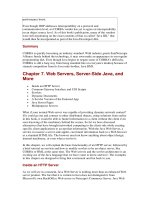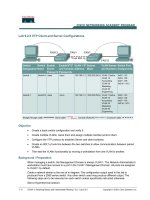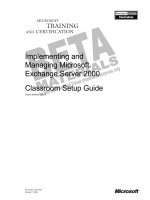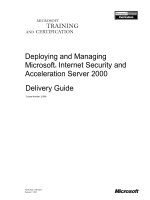QlikView server and publisher
Bạn đang xem bản rút gọn của tài liệu. Xem và tải ngay bản đầy đủ của tài liệu tại đây (3.1 MB, 176 trang )
www.it-ebooks.info
QlikView Server and Publisher
Deploy and manage QlikView Server and QlikView
Publisher on platforms ranging from a single server to
a multiserver clustered environment
Stephen Redmond
BIRMINGHAM - MUMBAI
www.it-ebooks.info
QlikView Server and Publisher
Copyright © 2014 Packt Publishing
All rights reserved. No part of this book may be reproduced, stored in a retrieval
system, or transmitted in any form or by any means, without the prior written
permission of the publisher, except in the case of brief quotations embedded in
critical articles or reviews.
Every effort has been made in the preparation of this book to ensure the accuracy
of the information presented. However, the information contained in this book is
sold without warranty, either express or implied. Neither the author, nor Packt
Publishing, and its dealers and distributors will be held liable for any damages
caused or alleged to be caused directly or indirectly by this book.
Packt Publishing has endeavored to provide trademark information about all of the
companies and products mentioned in this book by the appropriate use of capitals.
However, Packt Publishing cannot guarantee the accuracy of this information.
First published: January 2014
Production Reference: 1130114
Published by Packt Publishing Ltd.
Livery Place
35 Livery Street
Birmingham B3 2PB, UK.
ISBN 978-1-78217-985-6
www.packtpub.com
www.it-ebooks.info
Credits
Author
Project Coordinator
Stephen Redmond
Jomin Varghese
Proofreader
Reviewers
Dirk Manuel
B. Diane Blackwood
Steve Dark
Indexer
Brian Diamante
Mariammal Chettiyar
Barry Harmsen
Graphics
Acquisition Editors
Ronak Dhruv
Usha Iyer
Production Coordinators
Meeta Rajani
Manu Joseph
Lead Technical Editor
Sharvari Tawde
Technical Editors
Arwa Manasawala
Shali Sasidharan
Copy Editors
Pooja Chiplunkar
Cover Work
Manu Joseph
Cover Image
Sheetal Aute
Sayanee Mukherjee
Lavina Pereira
Laxmi Subramanian
www.it-ebooks.info
About the Author
Stephen Redmond is CTO of CapricornVentis Limited (ventis.
com), a QlikView Elite Partner. He is the author of several books, including QlikView
for Developers Cookbook, Packt Publishing, and the popular DevLogix series for
SalesLogix developers.
In 2006, after working for many years with CRM systems, reporting and analysis
solutions, and data integration, Stephen started working with QlikView. Since
then, CapricornVentis have become QlikView's top partner in the UK and Ireland
territory, and with Stephen at the head of the team, they have implemented
QlikView in a wide variety of enterprises and large-business customers, across a
wide range of sectors, from public sector to financial services to large retailers.
Stephen regularly contributes to online forums, including the Qlik Community. His
QlikView blog is at , and you can follow him on Twitter
(@stephencredmond), where he tweets about QlikView, BI, data visualization,
technology in general, and occasionally marathon running.
I would like to thank my family for their ongoing support. None of
what I do, would be possible without them.
A big shout out to my colleagues in CapricornVentis who are the
best team to work with. I don't think that the world has seen a better
team of business solution consultants.
www.it-ebooks.info
About the Reviewers
B. Diane Blackwood has worked as a consultant implementing Business
Intelligence and Corporate Performance Management (BI and CPM) solutions
since 2005. She is currently employed by Strafford Technology Inc., a Business
Intelligence consulting firm ( She
has extensive experience in multiple industries (including micro-electronics,
heavy equipment manufacturing, medical, legal, and various retail industries)
implementing BI and CPM solutions. In 2010, she worked with El Camino Hospital
by creating data warehouse/data marts to feed QlikView, a "social business
discovery" software solution. Diane worked closely with Dr. Michael Gallagher,
former Director of Informatics at El Camino Hospital, whose enthusiasm for the uses
of QlikView in analyzing the hospital and medical data "infected" her.
In 2013, Diane Blackwood wrote Instant QlikView 11 Application Development, Packt
Publishing. Diane has also written several biographic encyclopedia articles, including
articles on Charles Babbage, Erving Goffman, and Isaac Asimov.
Thank you to Dr. Michael Gallagher for first showing me the
prescribing pattern analysis with QlikView.
www.it-ebooks.info
Steve Dark was a SQL Server/MS ASP developer, building web-based reporting
solutions until he was shown a demo of QlikView. Soon after this epiphany, Steve
left his previous employer to set up Quick Intelligence, a consultancy focusing
entirely on QlikView and delivering Business Intelligence solutions. Preferring to
stay at the coalface, Steve spends the majority of his time with clients by building
QlikView applications, managing QlikView deployments, and running projects.
He will be never tired of showing QlikView to new users and seeing that "jaw drop
moment". Steve is active on the Qlik Community and other social media sites by
sharing his enthusiasm for QlikView and assisting other users. Through his blog he
shares tutorials, examples, and insights about QlikView (you can read it at http://
www.quickintelligence.co.uk/qlikview-blog/).
Steve has been on the technical review team for QlikView 11 For Developers, QlikView
11 For Developers Cookbook (also by Stephen Redmond), and QlikView Scripting. All of
these titles are published by Packt Publishing.
I would like to thank my family for putting up with me being
constantly involved in these books and my other QlikView
endeavors. Hopefully, my children will at some point, pick up these
references and start coding, themselves!
www.it-ebooks.info
Barry Harmsen is an independent Business Intelligence Consultant based in the
Netherlands. Originally from a background of traditional Business Intelligence, data
warehousing, and performance management, in 2008 he made the shift to QlikView
and a more user-centric form of Business Intelligence.
After switching over to QlikView, Barry has completed many successful
implementations in many different industries, ranging from financial services to
telecoms, and from manufacturing to healthcare. Barry's QlikView experience
covers a wide variety of roles and subjects, including requirements analysis, design,
development, architecture, infrastructure, system administration, integration, project
management, and training.
In 2012, Barry co-authored the book QlikView 11 for Developers, Packt Publishing. This
book quickly established itself as one of the best ways to teach yourself QlikView.
Barry is also one of the core speakers at the Masters Summit for QlikView. This
three-day conference for QlikView developers covers advanced topics, and is
designed to take your QlikView skills to the next level. More information about
Masters Summit can be found at www.masterssummit.com.
Barry writes a QlikView blog at www.qlikfix.com, and can be followed on Twitter
via @meneerharmsen.
www.it-ebooks.info
www.PacktPub.com
Support files, eBooks, discount offers and more
You might want to visit www.PacktPub.com for support files and downloads related
to your book.
Did you know that Packt offers eBook versions of every book published, with PDF
and ePub files available? You can upgrade to the eBook version at www.PacktPub.
com and as a print book customer, you are entitled to a discount on the eBook copy.
Get in touch with us at for more details.
At www.PacktPub.com, you can also read a collection of free technical articles, sign
up for a range of free newsletters and receive exclusive discounts and offers on Packt
books and eBooks.
TM
Do you need instant solutions to your IT questions? PacktLib is Packt's online
digital book library. Here, you can access, read and search across Packt's entire
library of books.
Why Subscribe?
• Fully searchable across every book published by Packt
• Copy and paste, print and bookmark content
• On demand and accessible via web browser
Free Access for Packt account holders
If you have an account with Packt at www.PacktPub.com, you can use this to access
PacktLib today and view nine entirely free books. Simply use your login credentials
for immediate access.
Instant Updates on New Packt Books
Get notified! Find out when new books are published by following
@PacktEnterprise on Twitter, or the Packt Enterprise Facebook page.
www.it-ebooks.info
Table of Contents
Preface1
Chapter 1: Getting Started with QlikView Server
7
Supported Windows Servers
Other Windows options that you need to consider
9
10
IIS10
Authentication11
Browser11
Internet Protocol
11
Print spooler service
11
Windows hardware considerations
12
Memory12
CPU12
Ready reckoner
13
Virtualization13
Licensing and Server types
14
Client licenses
14
Named User license
Document license
Concurrent license
Usage license
14
15
15
16
QlikView Small Business Edition Server license
16
QlikView Enterprise Edition Server license
17
QlikView Extranet Server license
17
QlikView Information Access Server license
17
QlikView Publisher license
18
Deployment options
18
Single server
19
Server/Publisher20
Enterprise20
www.it-ebooks.info
Table of Contents
Service Oriented Architecture
21
QlikView Server
21
QlikView Management service
22
QlikView Web Server/Settings service
22
Directory Service Connector
22
QlikView Distribution Service
23
QlikView clients
23
QlikView Desktop Client
23
QlikView Plugin Client
24
QlikView Ajax Zero Footprint Client
24
QlikView iPad App
25
Summary25
Chapter 2: Standard Installation Process
27
Chapter 3: Exploring the QlikView Management
Console in Detail
39
Preparing the QlikView environment
28
Service Account
28
Microsoft .NET Framework 4.0
29
Connectivity29
Obtaining QlikView software
30
Confirming installation policies
30
Installing the QlikView Server step-by-step
31
Testing the implementation
38
Summary38
Looking at what has been installed
40
Services40
Folders41
Extensions42
QlikView Management Console
42
Licensing43
Adding and updating licenses
Managing client licenses
43
44
The Root and Mount folders
49
Understanding other QlikView Server settings
53
The QVS folder structure
Create the new Root and Mount folders
Licenses gotcha!
49
51
52
Alternate extensions path
53
Session collaboration
53
Logging54
Security56
Alerts56
[ ii ]
www.it-ebooks.info
Table of Contents
Management Service settings
57
Customize QlikView Web Server settings
58
The General tab
The Repository tab
The Auditing tab
The General tab
The Authentication tab
The AccessPoint tab
The Ajax tab
The Web tab
57
57
58
58
59
59
62
63
Summary64
Chapter 4: Managing and Securing QlikView Documents
Securing QlikView Documents
By license
Section Access
NTFS Access Control List (ACL)
Document Metadata Service (DMS)
Enabling DMS
Other Document properties
Document Server settings
65
66
66
66
67
68
68
70
70
Server Objects (collaboration)
71
Availability71
Performance72
Document metadata
73
QlikView Server reload tasks
75
Using Event Driven Execution (EDX)
76
Summary77
Chapter 5: Installing QlikView Server Enterprise
Installing the QMS and DSC service
Testing the services installation
QMC config
DSC config
Server certificates
Establishing the shared folder
Installing the QVS service
Testing the QVS installation
The Settings file
Installing the QDS (Publisher) service
Testing the QDS installation
QDS config
Creating the Publisher folders
Installing the QlikView Web Service on IIS
[ iii ]
www.it-ebooks.info
79
82
84
84
84
85
85
86
87
87
88
89
89
89
90
Table of Contents
Testing the web installation
91
QSS config
91
IIS settings
92
Website93
Connecting servers to QMS
93
Directory Service Connector
93
QlikView Servers
93
QlikView Distribution Server – Publisher
97
QlikView Web Server
99
Summary101
Chapter 6: Configuring the QlikView Publisher
Exploring the QMC Publisher components in detail
System setup
103
104
104
General105
Alert E-mail
105
E-mail Templates
106
Advanced106
Section Access Management
107
Source Documents
110
Supporting Tasks
110
Creating tasks
111
Reloading a task with manual distribution
112
Loop and reduce with automatic distribution
114
Summary116
Chapter 7: Alternative Authentication and
Authorization Methods
Types of Directory Service Provider (DSP)
Enabling DMS authentication and establishing ACLs in the QMC
DMS Authorization options
Configuring Directory Service Providers
Configuring a Configurable ODBC DSP
Configuring the DSP
117
119
120
121
122
123
124
Configuring a Configurable LDAP DSP
125
Configuring a Custom Directory DSP
Testing DSPs
Testing Custom Directory authentication
Enabling HTTP header authentication
129
130
130
132
Configuring the DSP
[ iv ]
www.it-ebooks.info
126
Table of Contents
QlikView ticket authentication
133
Enable CTE server authentication
133
Requesting a ticket
134
Ticket testing of VBScript
135
Summary137
Chapter 8: Monitoring and Troubleshooting QlikView Server
139
Locating and interpreting logfiles
140
Locating the QlikView Server logs
140
Locating the Publisher/Reload Engine logs
142
Locating the Directory Service Connector logs
143
Locating the Management Service logs
143
Locating the web server logs
143
Using QlikView administration dashboards
144
Configuring and using the QlikView System Monitor application
144
Using the QlikView Governance Dashboard
145
Using QlikView power tools
146
Server Agent
146
QV User Manager
147
SharedFileViewer148
Other power tools
149
Reviewing the Windows event logs
150
Summary151
Index153
[v]
www.it-ebooks.info
www.it-ebooks.info
Preface
I have been working with QlikView since 2006. Since I started, the way in which
QlikView has been deployed has changed considerably.
Originally, the majority of implementations were individual desktop licenses. There
was a user license distinction between Developer, Professional, and Analyzer, with
different rights between them. The Developer would create QlikView documents, load
data from the database, and then pass over to the Professional to create the UI. The
Analyzer user would just open QlikView documents but couldn't edit them.
The QlikView Server was quite a young product. There was also a sister product called
QlikView Publisher—but that had a different development cycle and different version
numbers. The clients were QlikView Desktop, IE Plugin, Java, and the embryonic Ajax
Zero Footprint. The Management Console was a Windows executable file.
Version 8 of QlikView brought the development of Server and Publisher together
(well, they had the same version number anyway!). Every deployment of Server
could have a "Standard" license of Publisher, which allowed reload tasks only.
Enterprise Publisher required a license and had a separate management console.
The important thing to note was the improved Ajax ZFC client and the ability to
manually generate the HTML code for a site from within QlikView Desktop. That
made the QlikView Desktop very easy to deploy and made it a real alternative to the
IE plugin. Developers no longer had to enter a license key; they could "Borrow" their
user CAL from the server into their client.
www.it-ebooks.info
Preface
Version 9 brought the management of QlikView Server and Publisher together,
into a single, web-based management console. Well, actually there were two! The
QlikView Management Console (QMC—a simplified interface especially for
managing single server implementations) and the QlikView Enterprise Management
Console (QEMC—a more advanced interface especially for managing multiple server
deployments). To enable Publisher, you just added the license key, and the Publisher
options became available. We no longer had to manually generate the HTML for the
Ajax ZFC. You just needed to deploy the QVW and it would appear in the AccessPoint;
if a user opened it, the HTML was generated automatically. Licensing also changed,
and we got rid of the old Developer/Professional/Analyzer licenses and replaced
them with just the Named User license, which you borrow (although now renamed to
"Lease") from the server. Document licenses were introduced later.
Version 10 brought some great performance improvements, and a new skin for QMC
and QEMC. There were also some advancements made in APIs that allowed the
development of applications that made calls to the Management Service to retrieve
information—this was the genesis of the power tools. Extension objects for the Ajax
client were introduced. The old Java client was dropped. Service releases later saw
the Ajax client become gesture-aware so that it could be used on iPads and Android
devices.
Version 11, the current version, got rid of QMC and just uses QEMC, although
this has actually been renamed as QMC! There were many great improvements,
including a really good re-design of the Ajax views. The Ajax ZFC client is now
a valid default client for organizations. Other features for the Ajax client, such as
session collaboration, are not available in other clients. Document extensions have
been introduced.
I feel lucky, in a way, that we started selling QlikView at that time when more deals
started to include QlikView Server instead of standalone implementations. Now,
more than 100 implementations later, almost all of them have been server based.
We have implemented all of the options across our various clients, and have hit, and
resolved, many roadblocks along the way.
In this book, short as it is, I have tried to distill as much of the knowledge gathered
over all those years into these pages. I hope that you find it useful.
What this book covers
Chapter 1, Getting Started with QlikView Server, begins the journey with details of
the supported Windows platforms for the QlikView Server, the things that you are
going to need to consider before implementation, the hardware considerations,
the different types of licenses available, and the deployment options.
[2]
www.it-ebooks.info
Preface
Chapter 2, Standard Installation Process, goes step-by-step through a standard
installation of QlikView Server, where all components are installed on one box.
Chapter 3, Exploring the QlikView Management Console in Detail, introduces us to
the QMC, the main management tool that we use with QlikView Server and other
QlikView services.
Chapter 4, Managing and Securing QlikView Documents, looks at different methods of
securing QlikView documents as well as some of the other properties that we can
manage via the QMC.
Chapter 5, Installing QlikView Server Enterprise, walks through a full implementation
of QlikView Server services on multiple servers, including implementing a QlikView
Server Cluster.
Chapter 6, Configuring the QlikView Publisher, explains how to configure options for
QlikView Publisher and how to create a trigger reload and other tasks.
Chapter 7, Alternative Authentication and Authorization Methods, goes through the
different options for authentication beyond Active Directory, by using QlikView's
DMS authentication models, including LDAP, HTTP header, and Custom Ticket
Exchange (CTE).
Chapter 8, Monitoring and Troubleshooting QlikView Server, reviews the log files that
you need to know about in order to monitor the services and resolve issues, and also
looks at some of the tools available to help you administer the QlikView Server.
What you need for this book
You need to have a server or PC that is capable of running QlikView Server (refer
to Chapter 1, Getting Started with QlikView Server, for details). You will need access
to the QlikView Downloads site or know someone who does (for example,
a QlikView Partner), and have some kind of license for QlikView Server.
If you are not an existing customer of QlikView, you won't have access to the
downloads or have a license. In that case, you will need to engage with a QlikView
Partner to access the files and to obtain an evaluation license for QlikView Server.
Who this book is for
If you are a server administrator willing to learn about how to deploy QlikView
Server for server management, analysis and testing, and use QlikView Publisher
for publishing of business content, then this is the perfect book for you. No prior
experience with QlikView is necessary.
[3]
www.it-ebooks.info
Preface
Conventions
In this book, you will find a number of styles of text that distinguish between
different kinds of information. Here are some examples of these styles, and an
explanation of their meaning.
Code words in text, database table names, folder names, filenames, file extensions,
path names, dummy URLs, user input, and Twitter handles are shown as
follows: "To get a "clean" uninstall, we can uninstall and then manually delete the
ProgramData\QlikTech folder."
A block of code is set as follows:
Option Explicit
' Establish some variables
Dim sServer, sSuccessURL, sFailURL
Dim sUser, sGroups, sGroupList
Dim sURL, sRequest, sResult, sTicket
Dim iStart
Any command-line input or output is written as follows:
QMSEDX.exe -task="Sales Analysis.qvw" -pwd=mypassword
New terms and important words are shown in bold. Words that you see on the
screen, in menus or dialog boxes for example, appear in the text like this: "The
QlikView Desktop has the option to Open in Server and connect to a QlikView
Server to open a document."
Warnings or important notes appear in a box like this.
Tips and tricks appear like this.
[4]
www.it-ebooks.info
Preface
Reader feedback
Feedback from our readers is always welcome. Let us know what you think about
this book—what you liked or may have disliked. Reader feedback is important for
us to develop titles that you really get the most out of.
To send us general feedback, simply send an e-mail to ,
and mention the book title via the subject of your message.
If there is a topic that you have expertise in and you are interested in either writing
or contributing to a book, see our author guide on www.packtpub.com/authors.
Customer support
Now that you are the proud owner of a Packt book, we have a number of things to
help you to get the most from your purchase.
Downloading the example code
You can download the example code files for all Packt books you have purchased
from your account at . If you purchased this book
elsewhere, you can visit and register to
have the files e-mailed directly to you.
Errata
Although we have taken every care to ensure the accuracy of our content, mistakes
do happen. If you find a mistake in one of our books—maybe a mistake in the text or
the code—we would be grateful if you would report this to us. By doing so, you can
save other readers from frustration and help us improve subsequent versions of this
book. If you find any errata, please report them by visiting ktpub.
com/submit-errata, selecting your book, clicking on the errata submission form link,
and entering the details of your errata. Once your errata are verified, your submission
will be accepted and the errata will be uploaded on our website, or added to any list of
existing errata, under the Errata section of that title. Any existing errata can be viewed
by selecting your title from />
[5]
www.it-ebooks.info
Preface
Piracy
Piracy of copyright material on the Internet is an ongoing problem across all media.
At Packt, we take the protection of our copyright and licenses very seriously. If you
come across any illegal copies of our works, in any form, on the Internet, please
provide us with the location address or website name immediately so that we can
pursue a remedy.
Please contact us at with a link to the suspected
pirated material.
We appreciate your help in protecting our authors, and our ability to bring
you valuable content.
Questions
You can contact us at if you are having a problem with
any aspect of the book, and we will do our best to address it.
[6]
www.it-ebooks.info
Getting Started with
QlikView Server
At a simple level, QlikView Server is a product that serves QlikView documents to
connected users.
www.it-ebooks.info
Getting Started with QlikView Server
Users connect to AccessPoint—the out of the box QlikView web portal—and
see their documents. They click on a document and it opens, displaying their
up-to-date data.
Of course, under the hood, it is a lot more complex than that. There are multiple
services in action. The main one is the QlikView Server service that actually loads
the documents into memory on the server and delivers the information to clients.
The QlikView Web Server service hosts AccessPoint and renders the QlikView
documents to web and mobile clients. The Directory Service connector allows
QlikView to connect to different user repositories and the QlikView Management
service links everything together.
Up-to-date data is important to users, so we have the QlikView Distribution Service.
Without a QlikView Publisher license, this is a simple reload engine that reloads the
documents on a schedule. After adding the Publisher license, the Distribution Service
becomes a service that reloads documents and distributes them to multiple locations
with multiple options and schedules.
Before you begin to think about installing QlikView Server, there are some
important things that you should know. We will cover them all in this chapter.
When you install the product, you are going to need some hardware in place—
either physical or virtual—so you will need to understand the implications of
different configurations and sizes.
Because QlikView is built on a Service Oriented Architecture (SOA), we will also
look at the architecture of the different services so that you might understand how
many servers you might need to deploy.
We will also look at the different licenses that you can use with QlikView Server
and the different client types that can be deployed.
These are the topics we'll be covering in this chapter:
• Supported Windows Servers
• Licensing and Server types
• Deployment options
• Service Oriented Architecture
• QlikView clients
[8]
www.it-ebooks.info
Chapter 1
Supported Windows Servers
QlikView is a Windows-based technology. Up to Version 11.2 SR4, there have been
both 32-bit and 64-bit versions of QlikView Server (and Publisher).
These versions can be installed on the following Windows Server versions:
• Windows Server 2003, both 32-bit and 64-bit
• Windows Server 2003 R2, both 32-bit and 64-bit
• Windows Server 2008, both 32-bit and 64-bit
• Windows Server 2008 R2 (64-bit only)
For purposes of testing and development only, QlikView Server 32-bit or 64-bit
can also be installed on the following professional (not home edition) desktop
operating systems:
• Windows XP, both 32-bit (SP3) and 64-bit (SP2)
• Windows Vista, both 32-bit and 64-bit
• Windows 7, both 32-bit and 64-bit
Essentially, this is the list of operating systems that support the Microsoft .NET
Framework 4.0, which is required by QlikView Server.
Since version 11.2 SR2, an additional installation is available specifically
for Windows 2012. This version will also install on Windows 8, for test and
development purposes only.
QlikView Server will install on a fairly barebones Windows Server. The only
additional requirement is an installation of the Microsoft .NET Framework—v4
for QlikView v11 and v11.2. If the .NET Framework is not installed when you
start the QlikView Server installation, the QlikView installer will attempt to
start the download and installation process for it.
[9]
www.it-ebooks.info
Getting Started with QlikView Server
Of course, this means that if the server is not connected to the Internet, the download
will fail.
The installation will automatically create the QVPR (this is a legacy from the
QlikView Publisher Repository, but it is not just about publisher any longer), an
XML file-based storage of server settings managed by the QlikView Management
service. Because these XML files are potentially corruptible on the filesystem, some
administrators would prefer to have them stored in a more robust database. There is
an option in the QlikView Management Console, to migrate the QVPR to SQL Server.
This SQL Server could be running on the same server as the QlikView services but it
is not recommended, as it will consume resources that might be needed by QlikView.
It is worth noting that if you keep using the XML repository, the XML files will be
backed up to ZIP files on either a daily basis or on a schedule that you can configure.
Other Windows options that you need to
consider
There are a number of other Windows options that you need to consider before
deploying QlikView Server.
IIS
To run the QlikView AccessPoint, QlikView Server has its own web server service—
QlikView Web Service/Settings Service (QVWS). However, it will also deploy on
IIS v6, v7, or v8 (on Windows 8/2012). This may be the preferred option for many IT
departments, especially if they have existing IIS management experience or need to
easily manage security certificates.
[ 10 ]
www.it-ebooks.info









